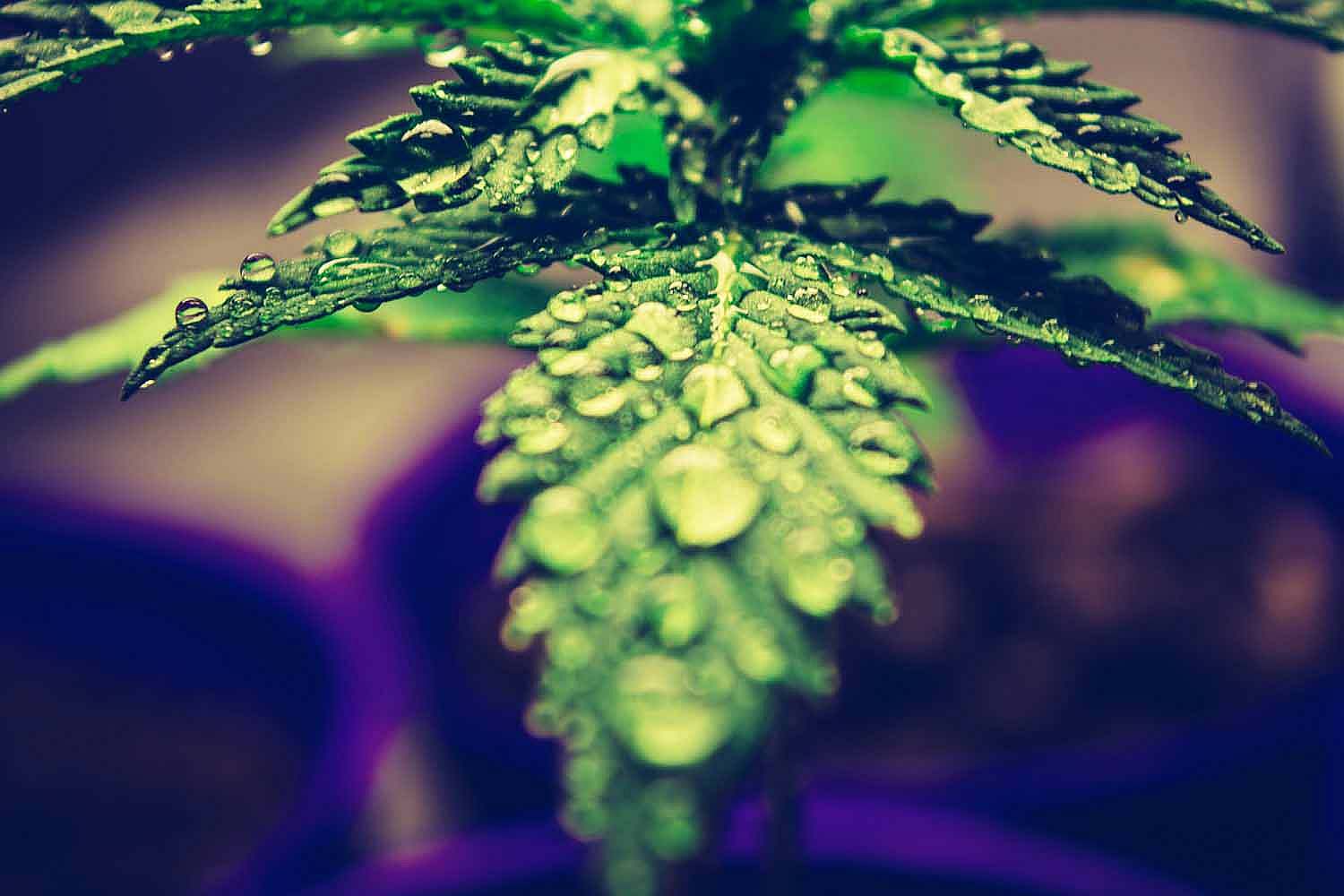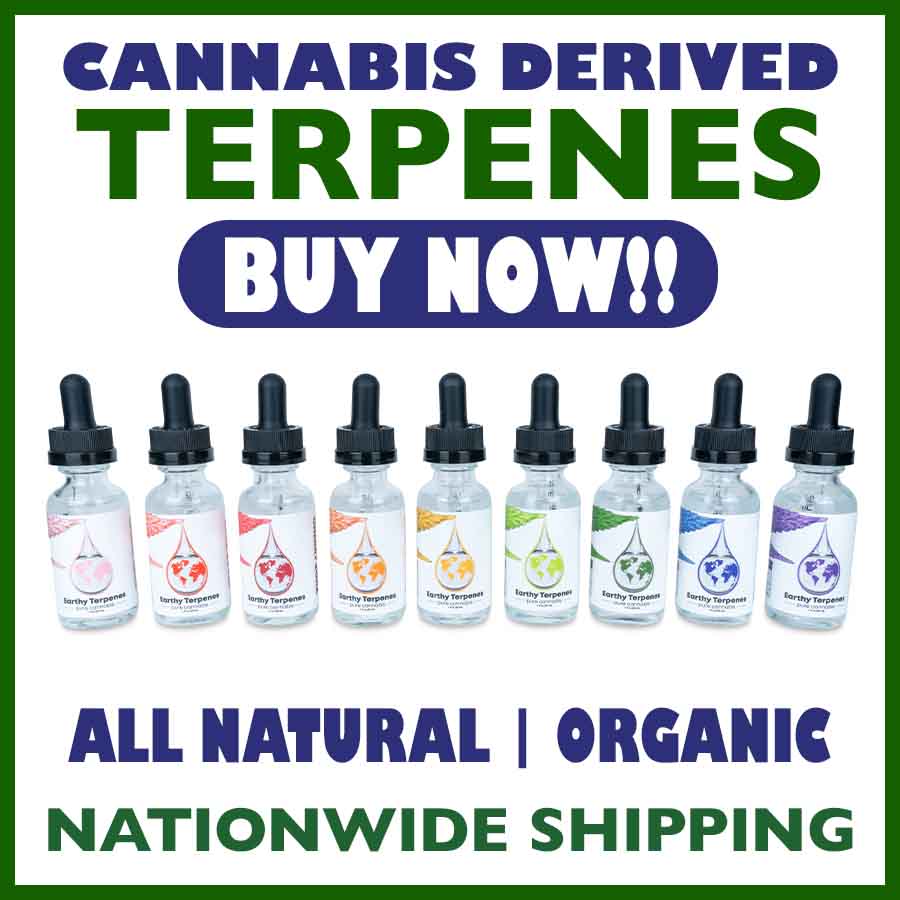You may already be familiar with the top 20 cannabis derived terpenes and not know it. With all of the recent crossbreeding and hybridization of cannabis, the cannabis industry can now offer hundreds of unique terpene profiles to consumers in the products they purchase.
In turn, each strain has a specific combination of terpenes that set it apart from other strains and determine how it smells and tastes. Put simply, terpenes found in cannabis behave much like essential oils. Cannabis plants just happen to have high concentrations of these beneficial compounds.
Cannabis companies can now extract the terpenes from different strains of cannabis and add them to tinctures, oils, cosmetics, beverages, and edibles to provide enhanced benefits to consumers. Some cannabis enthusiasts argue that various terpenes not only contribute to a strain’s smell and taste but also have other qualities and properties. These might include beneficial effects [1], though limited scientific evidence exists to prove these claims beyond common experiences.
Nonetheless, it’s helpful to understand what people find most appealing about common cannabis-derived terpenes in order to choose a strain best suited to your particular needs and desires. This list of the top twenty cannabis terpenes will help you demystify the nuanced world of cannabis terpenes.
What are terpenes?
A whiff of honeysuckle, a rose in full bloom, the smell of fresh-mown grass—all of these are borne from the release of terpenes into the air. But, terpenes do more than simply offer us olfactory pleasure. The evolutionary roles of both cannabis terpenes and botanical terpenes serve to protect a plant from predators, as well as attract pollinators. A particularly repellent smell, for instance, might help the plant stay out of the path of an animal who wishes to eat it. On the other hand, terpenes play a vital role in luring helpful insects to flowers to ensure the plant’s survival through pollination [2].
Though each cannabis flower contains over 100 terpenes [3], as well as various other cannabis compounds, the most prevalent terpenes have risen in popularity as consumers discover what terpene content makes their favorite strains especially enjoyable.
Cannabis terpenes and the entourage effect
The potential of cannabinoids such as THC and CBD is possible because of the body’s endocannabinoid system (ECS). This complex signaling system has evolved to utilize various compounds found in cannabis to regulate body functions—a process that is still being researched [4].
The cannabinoid receptors of this system are found in the brain, organs, connective tissues, glands, and immune cells of the human body [4]. Researchers have found that terpenes likely play a role in the entourage effect, thereby offering the potential to enhance the effects of cannabinoids [5].
The theory behind the entourage effect proposes that any potential inherent properties of the cannabinoids, whether relaxing, invigorating, mind expanding or otherwise, may be elevated when all of the cannabis compounds work together in the ECS. As such, terpenes may work in harmony with cannabinoids and flavonoids to make the cannabis plant even more powerful. According to the theoretical principles behind the entourage effect, products such as full-spectrum CBD oils utilize the whole of the hemp plant, along with its terpenes, to produce a more comprehensive experience [4].
Learn more in the Guide to CBD.
Are terpenes legal?
The 2014 Farm Bill removed hemp from the list of Schedule 1 substances and sewed the seeds for hemp’s recent resurgence. The Bill prompted long-forbidden research into hemp-derived cannabinoids to begin in earnest.
The 2018 Farm Bill expanded on this, allowing people to produce, sell, and consume hemp-derived products with less than .3% Delta-9 THC per dry weight, making it clear to legal experts and cannabis growers that these products, including terpenes, were federally-compliant [6]. On the other hand, marijuana—defined as cannabis containing more than .3% Delta-9 THC—is still illegal in many states.
Neither hemp nor marijuana terpenes produce psychoactive effects. One main difference between the two types of cannabis plants is the type of cannabinoids associated with them. The most well-known cannabinoid in hemp, for instance, is the non-psychoactive CBD (cannabidiol), whereas, the main psychoactive cannabinoid in marijuana is THC (tetrahydrocannabinol).
These and other cannabinoids like CBG and CBN exist in both types of cannabis, and are protected by the Farm Bill if they derive from hemp. Delta-8 THC, Delta-10 THC, and even Delta-9 THC may be derived from federally compliant hemp. Legal cannabis products may contain any of these three types of THC as long as they contain less than .3% Delta-9 THC per dry weight.
So even if all pure cannabis terpenes contain zero THC, it’s important to remember that they must come from hemp to be protected by the Farm Bill’s legislation. Terpenes from marijuana may not be legal except in states that sanction adult-use of marijuana.
What are the top 20 cannabis-derived terpenes?
Some terpenes occur more often than others in cannabis, though the combinations and percentages of them may vary widely depending on the strain. Below are the top 20 terpenes found in the cannabis plant. As the list progresses, the overall amount of a particular terpene may be less in a strain but still have a place in the overall unique profile of the strain and its resulting entourage effect.
Myrcene
One of the most prominent terpenes found in cannabis, myrcene has a fragrance that has been described as peppery, spicy, herbal, floral, and woody. Myrcene is found in hops, bay, thyme, lemongrass, mango, verbena, and cardamom [7]. Although it has a pleasant odor on its own, myrcene is typically used by the perfume industry as a foundation ingredient for developing other fragrances. It is the most prevalent terpene in most cannabis strains, including all of Earthy’s cannabis-derived strains.
Limonene
A monoterpene with a fragrance that is often described as smelling of citrus fruits, limonene is high in many strains of cannabis and is also found in pines, red maple, silver maple, aspen trees, cottonwoods, hemlocks, sumac, cedar, and junipers. The terpene with the citrus aroma has been shown in some studies to possess anti-inflammatory qualities and is a popular additive in cosmetics, foods, and cleaning products [7]. You’ll find it is a major terpene in strains like Jack Herer and Suver Haze.
Pinene
Pinene is the most abundant terpene in the natural world and is found in its alpha and beta forms. It is responsible for the distinctive aroma of coniferous trees, particularly pine trees, from which it derives its name. Also found in rose gun, parsley, frankincense, guava, juniper, rosemary, and nutmeg, pinene is a primary constituent of turpentine [8]. Hawaiian Haze, Harlequin, and Cotton Candy Kush all feature pinene prominently.
Beta-Caryophyllene
Both cannabis Sativa and cannabis Indica strains tend to be high in beta-caryophyllene. This terpene can also be found in plants such as rosemary clove, hops, black pepper, oregano, cinnamon, and basil. With a spicy, earthy aroma that many describe as smelling like cracked pepper, beta-caryophyllene is high in strains such as Canna Cake, Super Sour, and Sour Diesel [10].
Ocimene
An isomeric hydrocarbon found in a variety of fruits and plants, ocimene is known for its sweet, woodsy aroma. Sometimes used in perfumes, ocimene occurs naturally in mint, parsley, pepper, basil, mangoes, orchids, and kumquats. Cannabis strains high in ocimene include Suver Haze and Sour Special.
Terpinolene
Terpinolene is characterized by its floral, citrus, and piney aromas, and is present in lilac, sage, rosemary, nutmeg, cumin, apple, and tea trees [11]. Although it is generally present in cannabis, it is usually in moderate amounts and predominantly in cannabis sativa strains with higher THC content. Besides being used as a preserving and flavoring agent in the food industry, it is also used to scent perfumes, soaps, and other cosmetic products [11]. Look for terpinolene levels to rank high in strains like Golden Pineapple, Sour Lifter, and Super Sour.
Alpha-Humulene
First identified in the essential oils of Humulus lupulus, or hops, alpha-humulene is said to have a “hoppy” beer-like taste and smell. Besides cannabis and hops, other sources of alpha-humulene include basil, ginger, cloves, black pepper, ginseng, and Vietnamese coriander [12]. Alpha-humulene also delivers a woody, herbaceous smell and is mostly found in sativa strains of cannabis. You’ll find a humulene in Candyland, White Widow, and Cherry Soda.
Linalool
Responsible for giving lavender its soothing aroma, linalool is also found in some citrus, birch, rosewood, laurels, and coriander. In cannabis plants, linalool typically smells floral, spicy, or woody. Cannabis strains high in linalool include Lifter and Hawaiian Haze.
Eucalyptol
This intense-smelling terpene is most abundant in the eucalyptus tree. Anecdotally touted for its medicinal purposes, eucalyptol is often added to cough and cold medicine [14]. Also present in cannabis, rosemary, bay leaves, sage, sweet basil, and the camphor tree, eucalyptol smells cool and refreshing. That’s why many companies incorporate this common terpene into skin balms and lotions. It is a common terpene found in Girl Scout Cookies, Headband, and Super Sour.
Alpha-Phellandrene
In the past, both alpha-phellandrene and beta-phellandrene were sometimes misidentified as pinene or limonene. Yet, after advanced testing of these terpenes, researchers discovered they are distinct isomeric compounds [14]. Alpha-phellandrene gets its name from Eucalyptus phellandrene. Although it is most prominent in eucalyptus plants, alpha-phellandrene can be found in dill, black pepper, mint, parsley, cinnamon, lavender, pine, ginger grass, and water fennel. Find a phellandrene in the profile of strains like Suver Haze and Ace of Spades.
Alpha-Terpinene
Occurring naturally in a variety of plants including allspice, eucalyptus, citrus, juniper, cardamom, and marjoram, alpha-terpinene is known for its smoky, woody aroma. This monoterpene is commonly used to scent cleaning fluids as well as utilized as an ingredient in beauty products, pharmaceuticals, and foods. In tea tree oil, αlpha-terpinene has been shown to possess potential antioxidant properties [15]. Sour Special, Hawaiian Haze, and Ghost Train Haze all have alpha terpinene represented in their bouquets.
Guaiol
Guaiol’s woody and floral scent lends a rich pungency to cannabis strains such as Sour Suver. Also found in cypress and guaiacum wood, this lesser-known terpene is unlike many others in that it has a liquid structure instead of oil. The guaiacum plant, in which guaiol is high, has been used since the 18th century in the form of guaiacum gum. Those familiar with the Cinex, Suver Haze, or Fruit Loops strains will recognize this terpene.
3 Carene
Cannabis-derived 3 carene gives off a heady, sweet scent with hints of citrus and cypress. Other plants that feature this terpene include rosemary, pine, and cedar. Commonly used in cosmetics, 3 carene is also used in insect repellents. This terpene is found in strains such as Sour Lifter and AK-47.
Camphene
Summer in humid areas wouldn’t be the same without the smell of citronella candles and the relief they bring from mosquitos. That aroma comes from camphene. Once used as an alternative to whale oil and burned in lamps, camphene is also found in camphor, cypress, spruce, ginger, rosemary, sage, and valerian. Most cannabis strains contain camphene in concentrations below 0.2% [18]. OG Kush and Sour Special are example strains whose profile includes camphene.
Fenchol
Naturally occurring in basal and aster flowers, fenchol is a secondary cannabis terpene prized for its earthy and camphor-like smell. Used in perfumes and detergents, fenchol has shown efficacy in a number of other areas as well [19]. Look for fenchol in OG Kush and Sour Lifter to experience it firsthand.
P-Cymene
Found in plants such as thyme, cumin, coriander, eucalyptus, cilantro, and oregano, this terpene expresses an earthy or “musty” aroma. A secondary cannabis terpene, you’ll find that this terpene is an important one in Lemon Skunk and Lifter.
Sabinene
Though the presence of sabinene is relatively low in many cannabis varieties, strains that give off a peppery, piney or mint aroma likely contain at least some of this terpene [21]. A constituent of carrot seed oil and black pepper, sabinene is also found in oak, Norway spruce, tea tree, nutmeg, basil, marjoram, cloves, and cardamom. This fresh-smelling terpene is used to flavor foods and scent perfumes. Sabinene features in strains like Mimosa and Tangerine Dream.
Valencene
Named after the Valencia orange, valencene is a sesquiterpene, meaning that it is a more complex type of terpene than monoterpenes like pinene or limonene [23]. Citrusy and sweet, the smell of valencene has also been likened to freshly cut wood and fresh herbs. It is unsurprisingly found in Tangie and Agent Orange, as well as Lifter and Cherry Soda.
Nerolidol
Also called peruviol and penetrol, nerolidol is reminiscent of the smell of apple, citrus, rose, and fresh bark. It’s often added to skin care products because it is easily absorbed and can enhance the absorption of other substances. While humans enjoy its smell and taste, pests stay clear of it, making it an ideal agent for warding off insects [24]. The profiles of Jack Herer, GG4, and Suver Haze wouldn’t be the same without nerolidol.
Borneol
Borneol is a fresh and minty-tasting cannabis terpene also naturally occurring in ginger, rosemary, camphor, and thyme. Haze strains of cannabis generally contain higher concentrations of borneol.
Know your top 20 cannabis terpenes
This list intends to educate cannabis enthusiasts about how different terpenes influence smell and taste as well as illuminate the traditional uses for the most prominent terpenes.
Bookmark this page so that you can review how terpenes function as you peruse different strains of cannabis. Having a little inside information can go a long way in navigating the exciting landscape of cannabis terpenes. Your olfactory neurons and taste buds will thank us later.
Disclaimer – Information is provided for educational purposes. It does not, and is not intended to, constitute legal advice or medical advice. We attempt to be accurate and up to date but the legality of cannabinoids and the science of cannabis is evolving. The author is neither a lawyer or a legal expert, nor a doctor or medical expert. You should check with your local authorities and medical providers before buying or using any products.
References
- The Anti Inflammatory Properties of Cannabis Terpenes
- The Role of Terpenes in Plants
- High Times Aroma Therapy Guide
- Getting High on the Endocannabinoid System
- Study Shows Cannabis Terpenes Provide Pain Relief and Contribute to Entourage Effect
- Farm Bill and Hemp CBD Explainer
- Evaluation of Anti Inflammatory Properties of Terpenes
- Wikipedia: Turpentine
- Review of Pinene and Linalool as Terpene Based Medicines for Brain Health
- Leafly: Caryophyllene Terpene
- Why You Should Know About Terpinolene and it’s Benefits
- Humulene Terpene
- Eucalyptol Terpene
- Everything You Need to Know About A-Phellandrene and its Benefits
- A-Terpinene – An Antioxidant in Tea Tree Oil
- Leafly – Guaiol Terpene
- Anti-inflammatory Effects of Bupleurum Essential Oil
- Camphene Terpene
- Screening Antibacterial Effects of 20 Terpenes
- Evaluation of Anti-Inflammatory Effects of P-Cymene
- Terpene Glossary Sabinene
- Antifungal, Anti-inflammatory Properties of Oenanthe
- Leafly – Cannabis Terpenes Terpineol Valencene Geraniol
- Nerolidol Terpene
- Borneol
- 15 Terpenes Explained Canna Con







